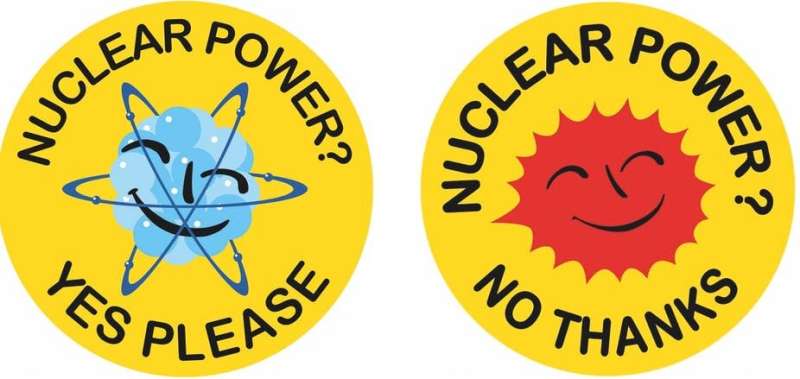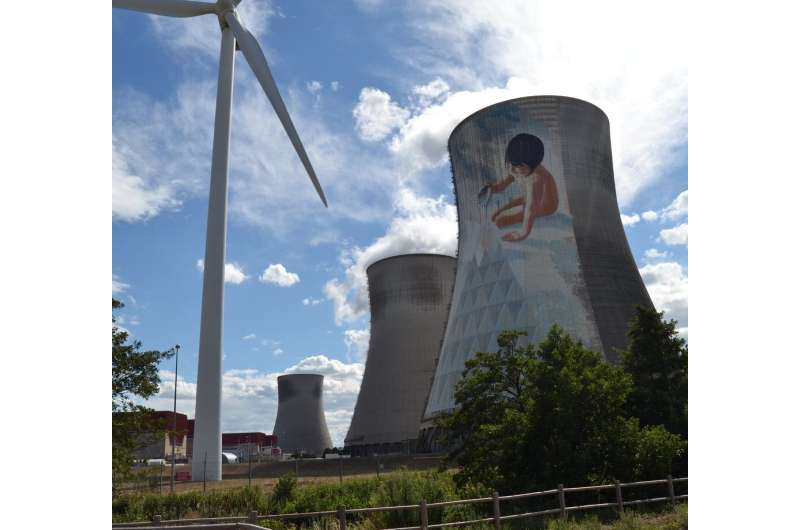Can’t decide? Let scientists guide your thinking. Credit: Nuclear Yes Please/Wise International
French president Emmanuel Macron has recently announced that France will invest €1 billion into nuclear power, and build more reactors by 2030 to help stave off Europe's energy crisis.
But even in France, where nuclear provides more than 70% of the country's energy mix, the issue is controversial.
The debate is particularly polarized among those who live near nuclear power plants, depending on whether or not they profit either materially or symbolically from this proximity. There is also a constant tension between the press and the nuclear sector over coverage of the industry.
Decades since the first nuclear power plant was built, the debate is still hindered by misunderstandings over both the advantages and drawbacks of this technology.
Contrasting views
As physicists, the two of us mainly agree on the scientific and technological basics of the debate, and on every argument based on verifiable facts. But our different sensibilities as citizens lead us to weigh each argument differently and reach different conclusions on nuclear power.
One of us (Stefano Panebianco) estimates that the advantages of this technology make it a viable choice for the future, while the other (François Graner) estimates that our efforts should focus on a significant decrease in our energy consumption.
By drawing on our contrasting views based on a shared understanding of the scientific evidence, we want to help others form an opinion by listing the pros and cons of nuclear power using the rigorous methods of our everyday life as scientists.
To do so, we asked experts from across the spectrum, including physicists, economists, political scientists, anthropologists, historians, journalists, and NGO volunteers to contribute to a review of the major questions relating to nuclear power. The collected works do not provide a conclusion: we leave it to the readers to draw their own.
So, how should you make up your mind? Here are the basics.
Making choices about the future
The physics underlying nuclear production of electricity are well known. It is rather the industrialisation of the process that raises questions.
Scientific and technological research organizations try to anticipate future energy needs and develop new types of nuclear reactors to replace existing ones. Such research should not predict future choices to be made by politicians and society. However, it is a long-term process which often takes several decades of research, design, development and experimentation before approval, and hence the choices of research directions today can be somewhat binding for the future.
For instance, the study of fast neutron breeder reactor design and optimisation is a long-standing research field. This would allow nuclear fuel to be recycled, which would preserve natural uranium resources and reduce nuclear waste.
In France, two successive demonstrators, Phenix and Super-Phenix, were built and operated last century and a third one, Astrid, was planned in recent years. However, all of these projects have been subject to successive government decisions to pursue, stop, resume, and recently in the case of Astrid, stop again, or at least defer. These decisions were made based on economic, environmental, political and strategical criteria.
How much does it cost?
Natural uranium, which is used as fuel in power plants, is still a relatively abundant resource and does not yet contribute much to the total cost of nuclear energy.
The French Court of Auditors estimated the current average generation cost of nuclear energy for a life-span of 50 years at €60 per megawatt-hour, equivalent to six cents per kilowatt-hour. Though comparisons with other electricity sources are difficult to make, the highly variable public sale price of electricity is around 15 cents per kilowatt-hour.
Cost estimates heavily depend on hypotheses about the future, including the prolongation of power plant duration, waste choices and the decommissioning of reactors. Although decisions are often taken within the short-term vision of an electoral mandate, waste policy must take long-term implications into account.
Cruas nuclear power station in southern France. Credit: Jean-Pierre Pertin
Meanwhile, the technical feasibility of decommissioning is still hard to predict owing to different levels of understanding of the various reactor types. To maintain or decommission a nuclear power plant requires anticipation in term of money, know-how and energy, and so largely engages the next generations.
Nuclear power thus requires long-term political, financial and geological stability.
Is it safe?
In public debates about safety, a purely technical subject has been transformed into a political one.
Radioactivity must be controlled throughout all stages of the nuclear fuel chain to prevent any harmful effects on either humans or the environment. The risk of nuclear accidents, whether related to natural events, human error, waste, malice or war, has been addressed over the decades by significant improvements and by experience feedback from the two main accidents of Chernobyl and Fukushima. However, it remains a major preoccupation for the general public.
Preventing accidents involves many factors, including the human one; the know-how and motivation of workers depend on a strong partnership between operator and subcontractors.
Other environmental impacts during normal operations include the exposure of nuclear workers and the public to chemical or thermal emissions: the latter becomes problematic with the global warming, as river water required to run reactors becomes scarce and warmer.
Does nuclear have a role in fighting climate change?
What is the future of nuclear power? Scientists cannot make predictions. Instead, scenarios are useful tools for examining possible consequences and costs of hypotheses or choices, for instance by decreasing greenhouse gas emissions or even decreasing energy demand.
The fact that nuclear power plants do not emit carbon, at least during the phase of electricity production (as opposed to the whole fuel and plant life cycles), is an argument to consider in the context of bringing down global emissions.
Nuclear plants also deliver constant power, which is a drawback in terms of adaptation to demand, but an advantage in terms of regularity: development of intermittent renewable energies such as solar and wind exert pressure on electricity distribution networks, as these energies are not necessarily always available at peak times.
The role of politics
In practice, global energy transition scenarios are often used to establish and endorse choices that have already been made.
Globally, the decisions which have actually been taken rely heavily on geopolitics, for instance attempts to bring down reliance on petrol imports, and also decisions to develop military nuclear power alongside energy policy.
The dual system of funding civil and military research alongside one another is only justified if nuclear weapons are developed, which is again a political decision.
Why it's so hard to decide
In deciding what to think about nuclear power, the list of arguments to take into account is frustratingly large, and many are coupled together. For instance, some reactors, loaded with the so-called mixed uranium and plutonium oxide fuel, partly contribute to recycle some nuclear products. Shutting them down could have the side effect of filling the current waste storage facilities more quickly than expected.
Even worse, decisions are often based on speculative hypotheses due to the difficulty of prediction. What is beyond doubt is that any decision taken or not taken today will affect future generations more than our own.
This means citizens should not leave decisions to be taken only on the basis of scientific or technical arguments, but should make up their own minds, taking into account the political and societal horizon they want for themselves and their children.
Provided by The Conversation
This article is republished from The Conversation under a Creative Commons license. Read the original article.![]()
























